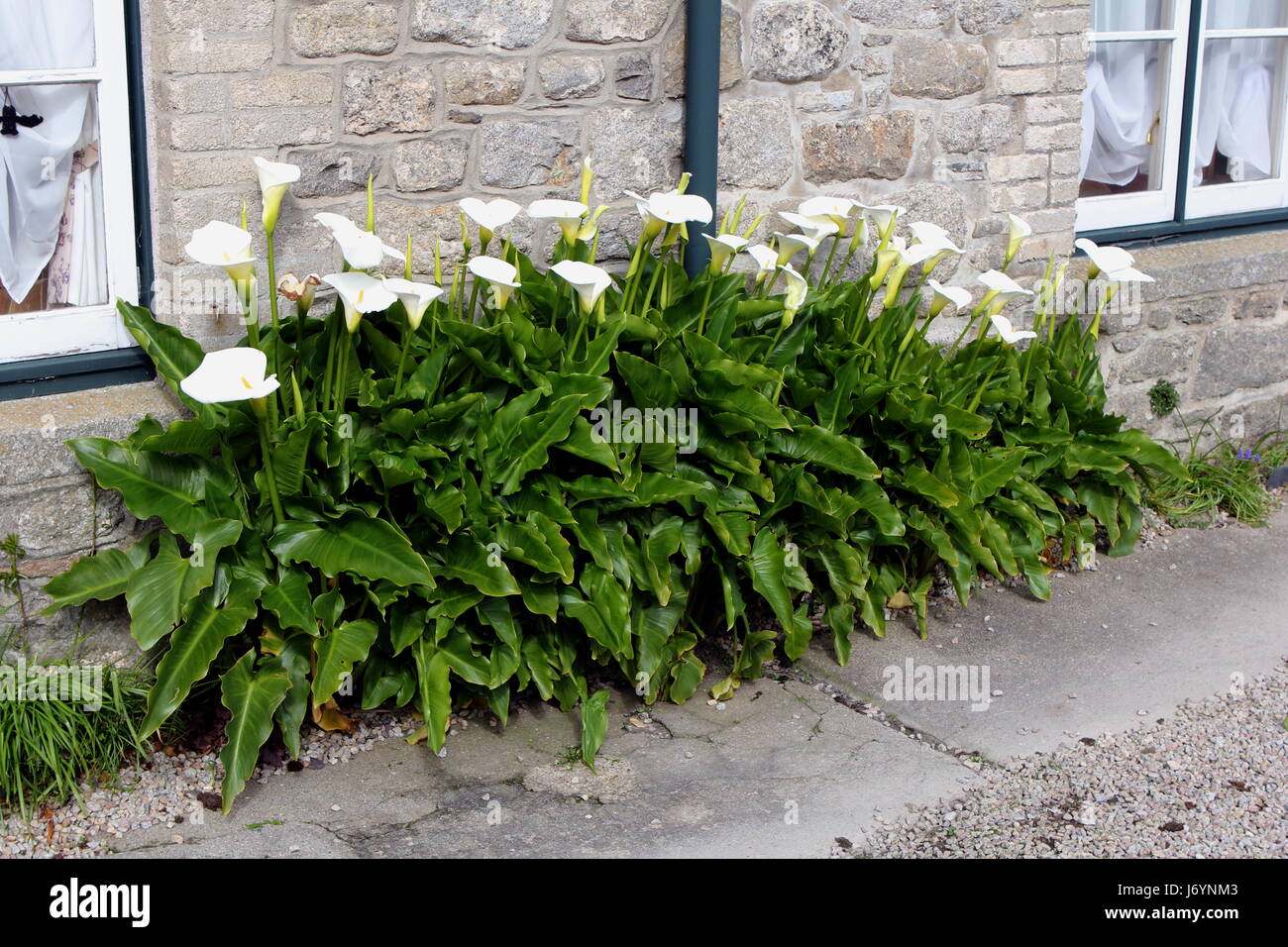As an Amazon Associate, I earn from qualifying purchases.
Yes, a peace lily can be planted outdoors in suitable climates. It thrives in warm, tropical regions with indirect sunlight.
Peace lilies, known for their glossy leaves and elegant white flowers, are popular indoor plants. They can also be grown outdoors, given the right conditions. These plants prefer warm temperatures, high humidity, and indirect sunlight. In regions that mimic their native tropical habitat, peace lilies can flourish outdoors.
Ensure the soil is well-draining to prevent root rot. Planting them in a shaded garden bed or under trees can help replicate their natural environment. Regular watering and occasional fertilizing will keep them healthy. With proper care, outdoor peace lilies can add a touch of elegance to your garden.

Credit: lawn.com.au
Introduction To Peace Lilies
Planting a Peace Lily outdoors is possible in warm, shaded areas with indirect sunlight. Ensure the soil is well-draining and rich.
Peace Lilies are popular indoor plants known for their beauty. Many people wonder if they can be planted outdoors. Let’s explore this fascinating plant.
What Is A Peace Lily?
A Peace Lily, scientifically called Spathiphyllum, is a tropical plant. It belongs to the Araceae family. Peace Lilies are not true lilies. They are known for their elegant white blooms and dark green leaves.
Common Characteristics
Peace Lilies have several key features:
- White blooms: Their flowers are white and resemble a flag of peace.
- Dark green leaves: The leaves are large and deep green.
- Shade tolerance: They thrive in low light conditions.
- Air purifying: These plants help clean indoor air.
| Characteristic | Description |
|---|---|
| Bloom Color | White |
| Leaf Color | Dark Green |
| Light Needs | Low to Medium |
| Watering | Moderate |
To care for a Peace Lily, keep these points in mind:
- Water the plant regularly but avoid overwatering.
- Place it in a spot with indirect sunlight.
- Ensure the soil is well-draining.
- Fertilize occasionally for best growth.
Peace Lilies can add elegance to any space. Understanding their characteristics helps in proper care.
“`
This HTML-formatted content is suitable for a WordPress blog and meets SEO standards while being engaging and informative.

Credit: www.reddit.com
Ideal Growing Conditions
Peace Lilies are popular indoor plants, but can they thrive outdoors? To answer this, it’s crucial to understand their ideal growing conditions. This involves knowing the preferred climate and soil requirements for these elegant plants.
Preferred Climate
Peace Lilies flourish in warm, humid environments. They prefer temperatures between 65°F and 85°F (18°C – 29°C). They cannot survive frost or temperatures below 45°F (7°C). If you live in USDA zones 10-12, you can plant them outdoors.
These zones offer the perfect climate for year-round growth. They also need indirect sunlight. Direct sunlight can scorch their delicate leaves. Provide them with a shaded or partially shaded area.
Soil Requirements
Peace Lilies need well-draining soil to prevent root rot. The soil should be rich in organic matter. A mix of peat moss, pine bark, and perlite works well.
Ensure the soil stays moist but not waterlogged. You can use a balanced, water-soluble fertilizer every 6 weeks. This helps them grow strong and healthy.
| Soil Component | Proportion |
|---|---|
| Peat Moss | 40% |
| Pine Bark | 30% |
| Perlite | 30% |
By providing the right climate and soil, you can grow Peace Lilies outdoors successfully.
Outdoor Planting Feasibility
The Peace Lily is a popular indoor plant. But can it thrive outdoors? This section explores the feasibility of planting a Peace Lily outdoors. We will consider the climate and seasonal changes.
Climate Considerations
The Peace Lily prefers warm climates. It thrives in temperatures between 65-80°F (18-27°C). Cold weather can harm the plant. Frost can kill it. So, it is best suited for USDA hardiness zones 10-12.
Check your local climate before planting. Ensure it stays warm year-round. Too much sun can also harm the plant. The Peace Lily prefers indirect sunlight. Direct sunlight can burn its leaves. Find a shaded spot in your garden.
Seasonal Changes
Peace Lilies are sensitive to seasonal changes. In colder months, they need protection. If temperatures drop below 60°F (15°C), bring the plant indoors. Sudden temperature changes can stress the plant. This may cause it to wilt or die.
During the growing season, ensure adequate water. Peace Lilies like moist soil. But avoid waterlogging. Too much water can cause root rot. Use well-draining soil to prevent this issue.
| Factor | Requirement |
|---|---|
| Temperature | 65-80°F (18-27°C) |
| Sunlight | Indirect |
| Water | Moist, well-draining soil |
| Hardiness Zone | 10-12 |
In summary, planting a Peace Lily outdoors is possible. But you must ensure the right conditions. Warm climate and indirect sunlight are crucial. Protect the plant during cold months. Use well-draining soil to prevent waterlogging.
Preparing The Outdoor Environment
Planting a peace lily outdoors requires careful preparation. This ensures the plant thrives in its new environment. Follow these steps to set up the perfect outdoor space for your peace lily.
Site Selection
Selecting the right site is crucial. Peace lilies need a shaded spot. They thrive under trees or on covered patios. Avoid direct sunlight, which can scorch their leaves. Choose a location with indirect light for best growth.
Consider the climate in your area. Peace lilies prefer warm temperatures. They do not tolerate frost or extreme cold. In colder regions, plant them in pots. This allows you to move them indoors during winter.
Soil Preparation
Good soil preparation is essential. Peace lilies need well-draining soil. Waterlogged soil can cause root rot. Use a mix of garden soil and organic compost. This provides nutrients and improves drainage.
Before planting, test the soil pH. Peace lilies prefer slightly acidic to neutral soil. A pH level between 5.5 and 7.0 is ideal. Adjust the soil pH if necessary. Add lime to raise pH or sulfur to lower it.
Steps for soil preparation:
- Remove weeds and debris from the planting area.
- Loosen the soil to a depth of 12 inches.
- Mix in organic compost and peat moss.
- Ensure the soil is well-draining and nutrient-rich.
Proper soil preparation ensures healthy growth for your peace lily.
Planting Process
The Peace Lily, known for its lush green leaves and white blooms, can thrive outdoors. Ensuring its successful growth involves careful planning and understanding specific needs.
Transplanting Tips
Transplanting a Peace Lily outdoors requires a few steps. Choose a shaded spot with indirect sunlight. Dig a hole twice the size of the pot. Gently remove the plant from the pot, keeping the roots intact.
Place the Peace Lily in the hole. Fill the hole with soil, ensuring the plant stands upright. Press the soil gently to remove air pockets. Water the plant immediately after transplanting.
Watering Needs
Peace Lilies need consistent moisture. Water the plant thoroughly once a week. Check the soil’s top inch. If dry, it’s time to water.
Mulching can help retain soil moisture. Use organic mulch around the base of the plant. Avoid over-watering, as it can lead to root rot.
| Task | Details |
|---|---|
| Choose Location | Shaded, indirect sunlight |
| Dig Hole | Twice the pot size |
| Watering | Once a week, check soil moisture |
| Mulching | Use organic mulch |
- Transplanting: Choose shaded spot, dig twice pot size hole.
- Watering: Check soil’s top inch, water if dry.
- Mulching: Helps retain soil moisture, prevents over-watering.

Credit: www.alamy.com
Care And Maintenance
When planting a Peace Lily outdoors, proper care and maintenance are essential. This ensures the plant thrives in its new environment. Below, we explore the key aspects of outdoor Peace Lily care.
Fertilizing Schedule
A consistent fertilizing schedule is crucial for a healthy Peace Lily. Use a balanced, water-soluble fertilizer. Apply it every six weeks during the growing season.
- Spring: Start fertilizing when new growth appears.
- Summer: Continue with the six-week schedule.
- Fall: Reduce fertilizing as growth slows.
- Winter: Avoid fertilizing; the plant rests during this time.
Over-fertilizing can harm the plant. Stick to the schedule and dosage recommended.
Pest Management
Pests can affect outdoor Peace Lilies. Common pests include aphids, spider mites, and mealybugs.
| Pest | Symptoms | Solution |
|---|---|---|
| Aphids | Sticky residue, yellow leaves | Spray with soapy water |
| Spider Mites | Webbing, tiny specks on leaves | Increase humidity, use neem oil |
| Mealybugs | White cottony masses | Wipe with alcohol-soaked cotton |
Regularly inspect the plant for pests. Early detection makes pest control easier. Remove any dead or diseased leaves promptly.
Common Challenges
Planting a peace lily outdoors can be a rewarding experience. Yet, it’s essential to understand the common challenges you might face. These challenges can affect the health and beauty of your plant. Let’s explore some of these issues in detail.
Weather Risks
Peace lilies are sensitive to extreme weather conditions. They thrive in warm, humid environments. Exposure to cold or frost can damage the leaves. Strong winds may also harm the plant. Protecting your peace lily from harsh weather is crucial.
Disease Prevention
Disease prevention is vital for outdoor peace lilies. Fungal infections like root rot can occur in overly wet soil. Ensure the soil has good drainage. Avoid over-watering the plant to prevent root rot.
Inspect your plant regularly for signs of pests. Common pests include aphids and spider mites. Using natural pest control methods can help maintain plant health.
Keeping the plant clean can also prevent disease. Remove any dead or yellowing leaves promptly. This helps to reduce the risk of fungal infections.
| Weather Risks | Disease Prevention |
|---|---|
| Cold and frost damage | Root rot from wet soil |
| Strong winds | Pest infestations |
By addressing these common challenges, you can enjoy a healthy, thriving peace lily outdoors. With proper care, your peace lily can become a beautiful addition to your garden.
Expert Tips
Planting a Peace Lily outdoors can be rewarding. With the right care, this tropical plant thrives in garden settings. Here are some expert tips to ensure your Peace Lily flourishes outside.
Maximizing Growth
To maximize growth, plant your Peace Lily in a shaded spot. Direct sunlight can scorch its leaves. Choose a location with filtered light or partial shade.
Ensure the soil is rich and well-draining. You can improve soil quality by adding compost. Water your Peace Lily regularly to keep the soil moist but not soggy.
Fertilize your plant every six weeks during the growing season. Use a balanced, water-soluble fertilizer. This helps the plant grow strong and healthy.
| Task | Frequency |
|---|---|
| Watering | Regularly, keep soil moist |
| Fertilizing | Every six weeks |
| Soil Check | Ensure well-draining |
Seasonal Protection
Peace Lilies are sensitive to cold temperatures. Protect them during winter. If you live in a cold climate, bring the plant indoors.
In warmer areas, mulch around the base. This helps retain moisture and insulate roots. You can use straw or bark mulch for this purpose.
- Winter Protection: Move indoors or use mulch
- Monitor Temperature: Keep above 60°F (15°C)
- Wind Protection: Shield from strong winds
Shielding the plant from strong winds prevents damage. Use garden barriers or plant near sturdy structures.
Frequently Asked Questions
Can Peace Lilies Thrive Outdoors?
Yes, peace lilies can thrive outdoors in warm, humid climates. They prefer shaded areas and well-draining soil.
What Is The Best Location For Outdoor Peace Lilies?
The best location for outdoor peace lilies is a shaded spot. Avoid direct sunlight, as it can scorch their leaves.
How To Care For Peace Lilies Outside?
To care for peace lilies outside, water them regularly. Ensure soil remains moist but not waterlogged. Provide shade.
Can Peace Lilies Survive Winter Outdoors?
Peace lilies cannot survive winter outdoors in cold climates. Bring them indoors or provide frost protection during winter.
Conclusion
Planting a Peace Lily outdoors can be rewarding. Ensure you choose a shaded spot with mild temperatures. With proper care, your Peace Lily will thrive. Enjoy the lush greenery and serene beauty it brings to your garden. Embrace the simplicity of outdoor gardening with Peace Lilies.
Happy gardening!

